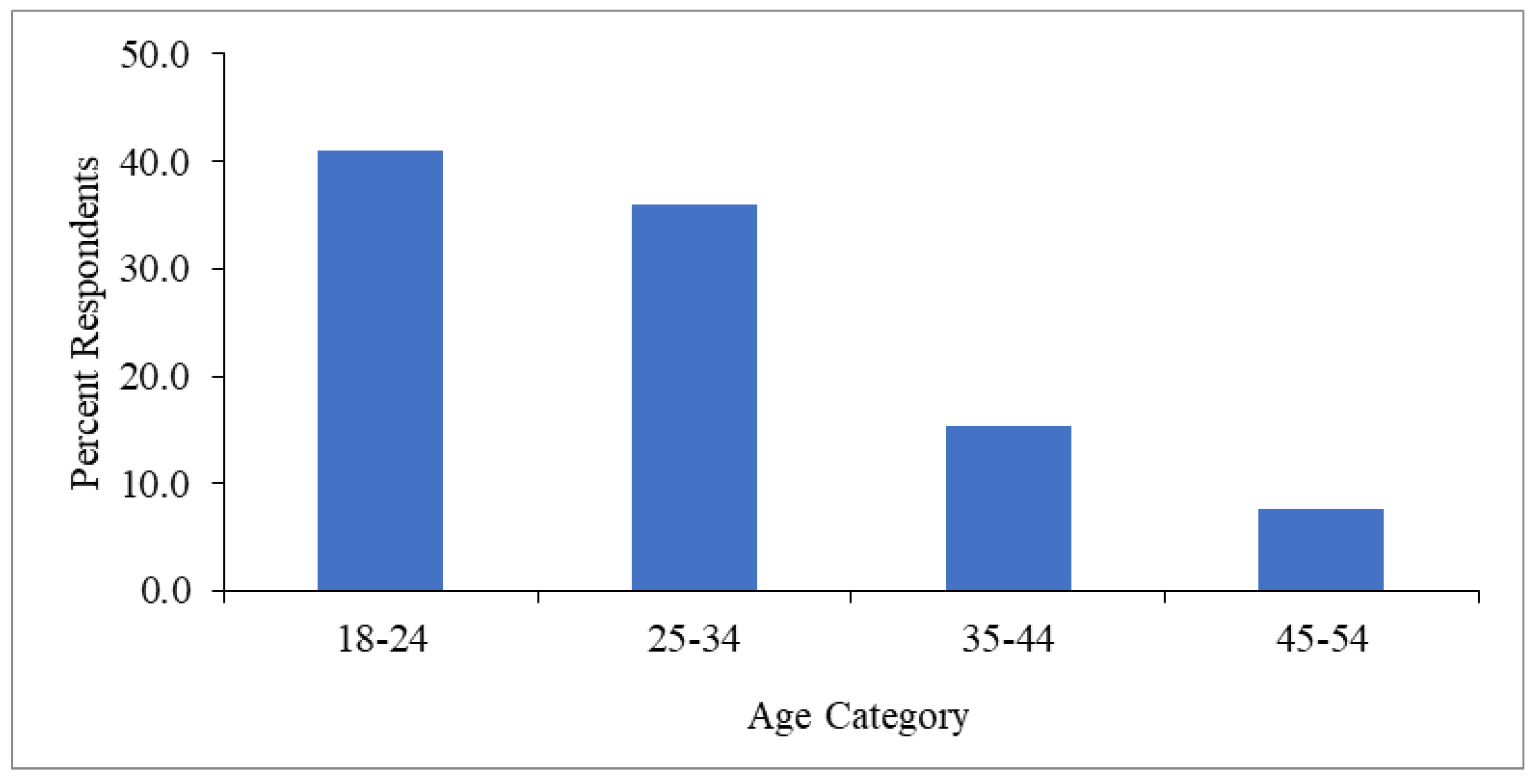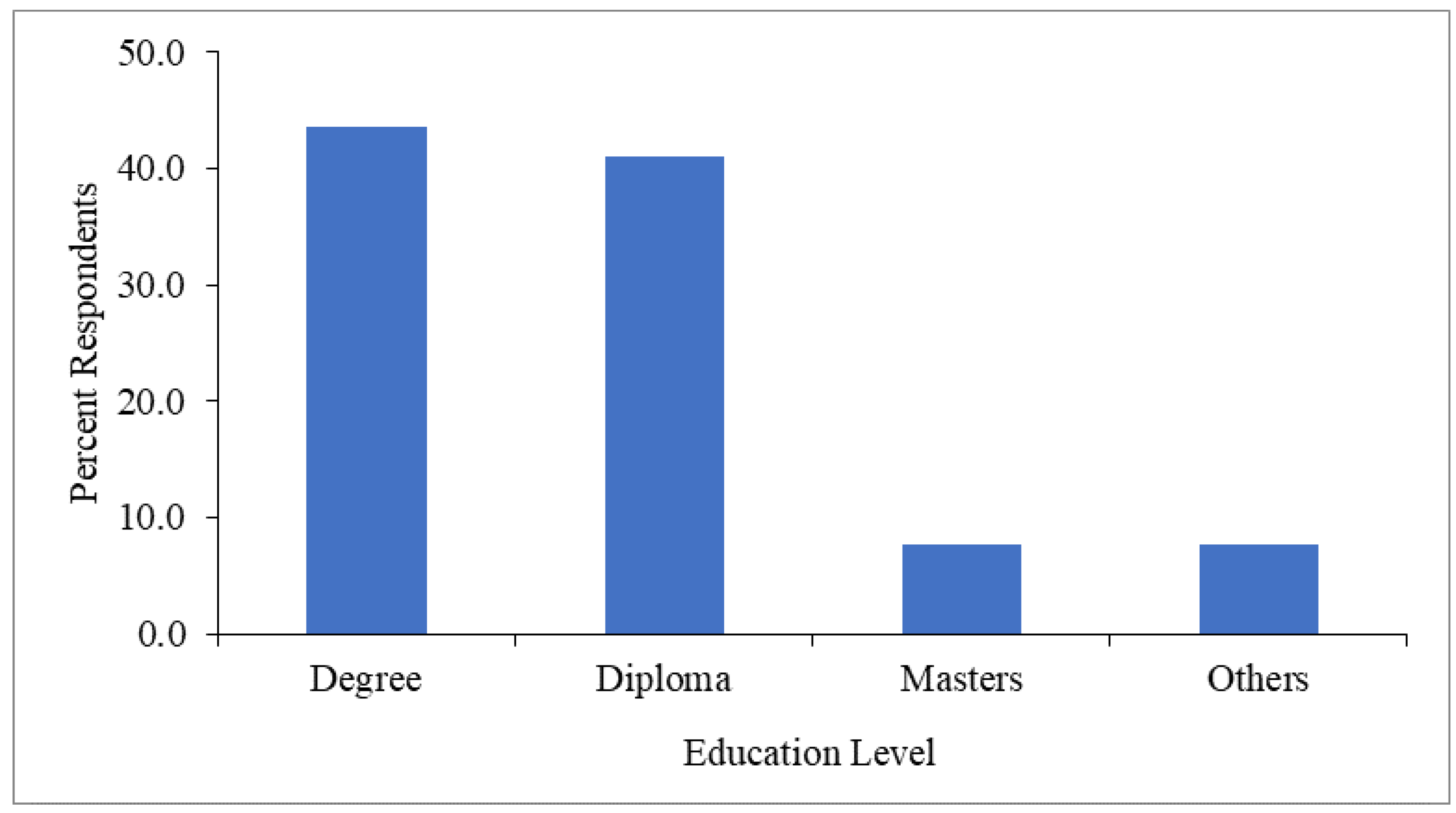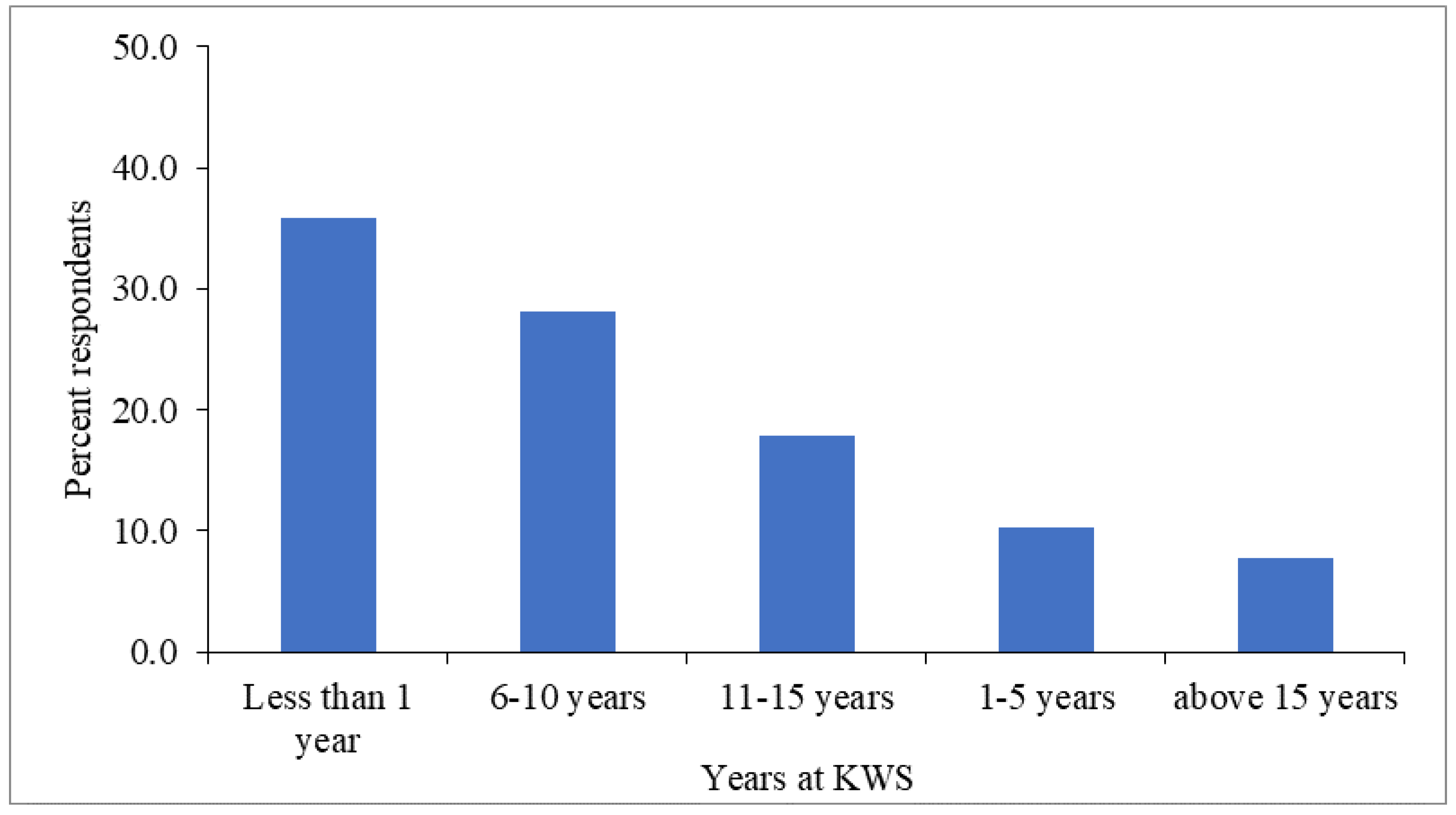Effect of Organizational Culture Change on Organizational Performance of Kenya Wildlife Service Nairobi National Park
Abstract
1. Introduction
2. Literature Review
2.1. Organization Culture
2.2. Organization Culture Change
2.3. Organizational Performance
2.4. Theoretical Review
2.4.1. Geert Hofstede’s Theory
2.4.2. Denison Dimension Model
3. Research Methodology
3.1. Research Design
3.2. Target Population
3.3. Sampling Frame
3.4. Sampling Technique
3.5. Sample Size
3.6. Description of Data Analysis Procedures
4. Research Results
4.1. Demographic Characteristics of the Respondents
4.2. Organizational Culture Change and Organizational Performance
4.3. Correlation between Culture and Performance
5. Discussion
Author Contributions
Funding
Institutional Review Board Statement
Informed Consent Statement
Data Availability Statement
Conflicts of Interest
Abbreviations
| KWS | Kenya Wildlife Service |
| SPSS | Statistical Package for Social Studies |
| NNP | Nairobi National Park |
| SD | Standard Deviation |
References
- Abolade, Dupe Abousima. 2018. Impact of Employees’ Job Insecurity and Employee Turnover on Organisational Performance in Private and Public Sector Organisations. Studies in Business and Economics 13: 5–19. [Google Scholar] [CrossRef]
- Ahmed, Mashal, and Saima Shafiq. 2014. The impact of organisational culture on organisational performance: A Case Study of the Telecom Sector. Global Journal of Management and Business Research: Administration and Management 14: 21–30. [Google Scholar]
- Aluko. 2003. The impact of culture on organizational performance in selected textile firms in Nigeria. Nordic Journal of African Studies 12: 16. [Google Scholar]
- Anne, Ngugi Wanjiku, and Nickson Agusioma Lumwagi. 2014. Effects of organizational culture on employee performance in non- governmental organizations. International Journal of Scientific and Research Publication 4: 72–86. [Google Scholar]
- Anyango, Gilbert Oduory, and Maende Chrispen. 2018. Structural change and organizational performance in Busia County referral hospital, Kenya. International Journal of Business Management & Finance 1: 1041–54. [Google Scholar]
- Chua, Joyce, Abdul Basit, and Zubair Hassan. 2018. Leadership style and its impact on Employee performance. International Journal of Accounting and Business Management 6: 80–94. [Google Scholar] [CrossRef]
- Cooper, Donald, and Pamela Schindler. 2014. Business Research Methods, 12th ed. New York: McGraw-Hill/Irwin. [Google Scholar]
- Ebba, Olyad. 2020. The Impact of Organizational Culture on Employee Performance: In the Case of Ethiopian Ethio Telecom. 197.156.93.91. Available online: http://197.156.93.91/bitstream/123456789/5968/1/final%20olyad%20ebba%20%2Cthe%20imapct%20of%20organizational%20culture%20on%20employees%20performanc%202.pdf (accessed on 2 August 2022).
- Garnett, James, Justin Marlowe, and Sanjay Pandey. 2008. Penetrating the performance predicament: Communication as a mediator or moderator of organizational culture’s impact on public organizational performance. Public Administration Review 68: 266–81. [Google Scholar] [CrossRef]
- Hasan, Halid, and Farika Nikmah. 2020. The effect of organizational culture, organizational learning and creativity on employee’s performance. In 2nd Social and Humaniora Research Symposium (SoRes 2019). Amsterdam: Atlantis Press, pp. 456–60. [Google Scholar]
- Hofstede, Geert. 1980. Motivation, leadership, and organization: Do American theories apply abroad? Organizational Dynamics 9: 42–63. [Google Scholar] [CrossRef]
- Hofstede, Geert, and Michael Harris Bond. 1988. The Confucius connection: From cultural roots to economic growth. Organizational Dynamics 16: 4–21. [Google Scholar] [CrossRef]
- Indiya, Gulali Donald, Johnmark Obura, and Jairo K. Mise. 2018. Effect of Organization Culture on organization performance on Public Universities in Kenya. European Scientific Journal 14: 15. [Google Scholar] [CrossRef]
- Jumanne, Shangarai Andrew, and Jane Njoroge. 2018. Structural change management and employee performance in public sector organizations in Kenya: Case of the parliamentary service commission. Journal of Strategic Management 3: 14–25. [Google Scholar] [CrossRef]
- Kabir, Syed Muhamad SSajjad. 2016. Methods of data collection. In Basic Guidelines for Research: An Introductory Approach for All Disciplines. Bangladesh: Book Zone Publication, chp. 9. pp. 201–75. Available online: https://www.researchgate.net/publication/325846997_METHODS_OF_DATA_COLLECTION (accessed on 2 August 2022).
- Kandula, Srinivas. 2006. Performance Management. New Delhi: IN.Prentice Hall of India Private Limited. [Google Scholar]
- Karanja, Carolyne. 2014. Strategy Implementation Practices and Organizational Performance in Commercial Banks in Kenya. Doctoral dissertation, University of Nairobi, Nairobi, Kenya. [Google Scholar]
- Kimhi, Shaul, and Yarden Oliel. 2019. Change management and organizational performance in selected manufacturing companies in Anambra state, Nigeria. The International Journal of Social Sciences and Humanities Invention 6: 5437–45. [Google Scholar]
- Magee, Kimberly Clauss. 2002. The Impact of Organizational Culture on the Implementation of Performance Management. Doctoral dissertation, Georgia State University ProQuest Dissertations Publishing, Atlanta, GA, USA. 2002.3047909. [Google Scholar]
- Matula, P. D., D. N. Kyalo, A. S. Mulwa, and L. W. Gichuhi. 2018. Academic Research Proposal Writing Principles, ‘Concepts and Structure’. Nairobi: African Centre for Technology Studies, (ACT). [Google Scholar]
- Mohammadi, Sara. 2020. Organizational culture and its impact on organizational productivity. International Journal of Human Capital in Urban Management (IJHCUM) 5: 267–76. [Google Scholar]
- Mugenda, Olive M., and Abel G. Mugenda. 2003. Research Methods: Quantitative and Qualitative Approaches. African Centre for Technology Studies 56: 23–34. [Google Scholar]
- Nikpour, Amin. 2017. The impact of organizational culture on organizational performance: The mediating role of employee’s organizational commitment. International Journal of Organizational Leadership 6: 65–72. [Google Scholar] [CrossRef]
- Onono, Edward. 2018. The Impact of Organizational Structure on Performance at General Electric Africa. Doctoral dissertation, United States International University-Africa, Nairobi, Kenya. [Google Scholar]
- Osoro, Grace Kemunto. 2020. Effect of Change Management Practices on Organizational Performance: A Case of United Nations Office for Projects and Services. Doctoral dissertation, United States International University-Africa, Nairobi, Kenya. [Google Scholar]
- Pakdil, Fatma, and Karen Moustafa Leonard. 2014. Criteria for a lean organisation: Development of a lean assessment tool. International Journal of Production Research 52: 4587–607. [Google Scholar] [CrossRef]
- Shahzad, Fakhar, Adeel Luqman, Rashid Ayesha Khan, and Lalarukh Shabbir. 2012. Impact of organizational culture on organizational performance: An Overview. Interdisciplinary Journal of Contemporary Research in Business 3: 975–85. [Google Scholar]
- Sinaga, Hendrik Gomar, Asmawi Moch, Adji Madhakomala, and Adji Suratman. 2018. Effect of change in management, organizational culture and transformational leadership on employee performance PT. AdhyaTirta Batam (PT. ATB). International Review of Management and Marketing 8: 15–23. [Google Scholar]
- Sîrbu, Mirela, and Doina Roúca. 2010. The impact of culture and organizational change on the economic performance of companies. Business & Leadership, 103–10. Available online: researchgate.net (accessed on 2 August 2022).
- Taherdoost, Hamed. 2016. Sampling methods in research methodology; How to choose a sampling technique for research. International Journal of Academic Research in Management (IJARM) 5: 18–27. [Google Scholar] [CrossRef]
- Too, Alicen. 2018. Effect of Organizational Culture on Change Management on County Governments of Kenya, a Case Study of County Government of Nakuru. Doctoral dissertation, Kabarak University, Nairobi, Kenya. [Google Scholar]
- ul Mujeeb, Ehtesham, and Shakil Muhamad Ahmad. 2011. Impact of organizational culture on performance management practices in Pakistan. International Management Review 7: 52–77. [Google Scholar]
- Wahjudi, Didik, Laksono Singgih, Patdono Suwignjo, and Imam Baihaqi. 2016. The relationship between organizational culture and firm performance: An empirical study on Indonesian manufacturing firms. International Journal of Productivity and Quality Management 18: 1–18. [Google Scholar] [CrossRef]
- Wanjohi, Susan Wangechi. 2014. Organizational Culture and Change Management Practice in the Kenyan Media Industry. Doctoral dissertation, University of Nairobi, Nairobi, Kenya. [Google Scholar]



| Statement | Response | |||||
|---|---|---|---|---|---|---|
| Strongly Disagree | Disagree | Neutral | Agree | Strongly Agree | SD | |
| Management ensures old habits that are not effective are dropped | 2.6 | 12.8 | 23.1 | 25.6 | 35.9 | 1.04 |
| Managers help employees to drop old habits of following rules and procedures | 15.4 | 12.8 | 25.6 | 25.6 | 20.5 | 1.34 |
| Managers encourage employees to be flexible when the environment is changing rapidly | 2.7 | 10.8 | 16.2 | 40.5 | 29.7 | 1.06 |
| Managers educate employees on how to determine if an existing culture is no longer effective | 5.1 | 23.1 | 35.9 | 20.5 | 15.4 | 1.12 |
| Statement | Response | |||||
|---|---|---|---|---|---|---|
| Strongly Disagree | Disagree | Neutral | Agree | Strongly Agree | SD | |
| Management ensures the organizational culture supports vision, goals, and strategies | 7.7 | 7.7 | 12.8 | 38.5 | 33.3 | 1.21 |
| Managers encourage employees to adapt to changes | 5.4 | 8.1 | 13.5 | 40.5 | 32.4 | 1.13 |
| Managers encourage employees to care about each other, customers and stakeholders | 5.1 | 7.7 | 17.9 | 35.9 | 33.3 | 1.13 |
| Managers are the role models to employees in the organization and set standards for ethics | 10.5 | 0.0 | 31.6 | 28.9 | 28.9 | 1.21 |
| Statement | Response | |||||
|---|---|---|---|---|---|---|
| Strongly Disagree | Disagree | Neutral | Agree | Strongly Agree | SD | |
| The organization has in place a culture of work that supports the implementation of vision and strategies | 5.1 | 7.7 | 25.6 | 28.2 | 33.3 | 1.1576 |
| Management gives appropriate incentives to employees that work within the organization’s work culture | 10.3 | 17.9 | 28.2 | 33.3 | 10.3 | 1.1594 |
| Managers monitor employees’ work habits to ensure consistency with the organization’s work culture | 5.1 | 7.7 | 20.5 | 38.5 | 28.2 | 1.111 |
| Mgt Ensures Old Habits Are Dropped | Mgt Helps Employees to Drop Habits | Mgt Encourages Employees to Be Flexible | Mgt Educates Employees If Culture Is Not Effective | Mgt Ensures Culture Supports Vision, Goals, and Strategies | Mgt Encourages Employees to Adapt to Changes | Mgt Encourages Care for Customers and Stakeholders | Managers Are Role Models to Employees | Culture Supports Vision and Strategies | |
|---|---|---|---|---|---|---|---|---|---|
| Mgt ensures old habits are dropped | 1 | 0.552 ** | 0.269 | 0.349 * | 0.382 * | 0.196 | 0.308 | 0.074 | 0.312 |
| Mgt helps employees to drop habits | 0.552 ** | 1 | 0.356 * | 0.477 ** | 0.639 ** | 0.487 ** | 0.488 ** | 0.454 ** | 0.626 ** |
| Mgt encourages employees to be flexible | 0.269 | 0.356 * | 1 | 0.512 ** | 0.652 ** | 0.689 ** | 0.432 ** | 0.576 ** | 0.614 ** |
| Mgt educates employees if existing culture is not effective | 0.349 * | 0.477 ** | 0.512 ** | 1 | 0.509 ** | 0.585 ** | 0.456 ** | 0.532 ** | 0.540 ** |
| Mgt ensures culture supports vision, goals, and strategies | 0.382 * | 0.639 ** | 0.652 ** | 0.509 ** | 1 | 0.743 ** | 0.629 ** | 0.699 ** | 0.796 ** |
| Mgt encourages employees to adapt to changes | 0.196 | 0.487 ** | 0.689 ** | 0.585 ** | 0.743 ** | 1 | 0.694 ** | 0.807 ** | 0.690 ** |
| Mgt encourages care for customers and stakeholders | 0.308 | 0.488 ** | 0.432 ** | 0.456 ** | 0.629 ** | 0.694 ** | 1 | 0.674 ** | 0.692 ** |
| Managers are role models to employees | 0.074 | 0.454 ** | 0.576 ** | 0.532 ** | 0.699 ** | 0.807 ** | 0.674 ** | 1 | 0.659 ** |
| Culture supports vision and strategies | 0.312 | 0.626 ** | 0.614 ** | 0.540 ** | 0.796 ** | 0.690 ** | 0.692 ** | 0.659 ** | 1 |
Publisher’s Note: MDPI stays neutral with regard to jurisdictional claims in published maps and institutional affiliations. |
© 2022 by the authors. Licensee MDPI, Basel, Switzerland. This article is an open access article distributed under the terms and conditions of the Creative Commons Attribution (CC BY) license (https://creativecommons.org/licenses/by/4.0/).
Share and Cite
Okwata, P.A.; Wasike, S.; Andemariam, K. Effect of Organizational Culture Change on Organizational Performance of Kenya Wildlife Service Nairobi National Park. Adm. Sci. 2022, 12, 139. https://doi.org/10.3390/admsci12040139
Okwata PA, Wasike S, Andemariam K. Effect of Organizational Culture Change on Organizational Performance of Kenya Wildlife Service Nairobi National Park. Administrative Sciences. 2022; 12(4):139. https://doi.org/10.3390/admsci12040139
Chicago/Turabian StyleOkwata, Phoebe Akoth, Susan Wasike, and Kifleyesus Andemariam. 2022. "Effect of Organizational Culture Change on Organizational Performance of Kenya Wildlife Service Nairobi National Park" Administrative Sciences 12, no. 4: 139. https://doi.org/10.3390/admsci12040139
APA StyleOkwata, P. A., Wasike, S., & Andemariam, K. (2022). Effect of Organizational Culture Change on Organizational Performance of Kenya Wildlife Service Nairobi National Park. Administrative Sciences, 12(4), 139. https://doi.org/10.3390/admsci12040139




